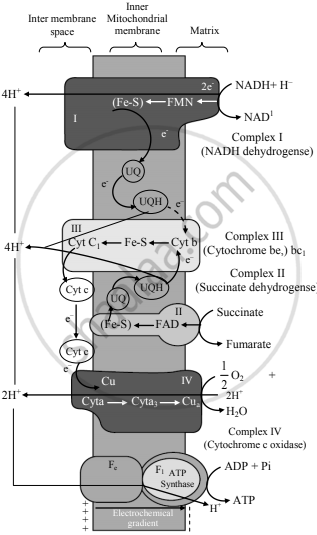Advertisements
Advertisements
प्रश्न
Answer the following question.
Explain ETS.
उत्तर
- NADH2 and FADH2 produced during glycolysis, connecting link reaction and Krebs cycle are oxidized with the help of various electron carriers and enzymes.
- These carriers and enzymes are arranged on the inner mitochondrial membrane in the form of various complexes as complex I, II, III, VI and V.
- NADH+H+ is oxidized by NADH dehydrogenase (complex I) and it's electrons are transferred to ubiquinone (coenzyme Q-CoQ) present on the inner membrane of mitochondria. Reduced ubiquinone is called as ubiqunol.
- FADH2 is oxidized by complex II (Succinate dehydrogenase) and these electrons are also transferred to CoQ.
- During oxidation of NADH+H+ and FADH2, electrons and protons are released but only electrons are carried forward whereas protons are released into the outer chamber of mitochondria (intermembrane space).
- Ubiquinol is oxidized by complex-III (Cytochrome bc1 complex) and it's electrons are transferred to cytochrome C. Cytochrome C is a small, iron-containing protein, loosely associated with the inner membrane. It acts as a mobile electron carrier, transferring the electrons between complex III and IV.
- Cytochrome C is oxidized by complex IV or cytochrome C oxidase consisting of cytochrome a and a3. Electrons are transferred by this complex to the molecular oxygen. This is terminal oxidation.
- Reduced molecular oxygen reacts with protons to form a water molecule called as metabolic water.
- Protons necessary for this are channelled from the outer chamber of mitochondria into the inner chamber by F0 part of oxysome (complex V) present in the inner mitochondrial membrane. This proton channelling by F0 is coupled to the catalytic site of F1 which catalyses the synthesis of ATP from ADP and inorganic phosphate. This is oxidative phosphorylation. As the transfer of protons is accompanied with a synthesis of ATP, this process is named as 'Chemiosmosis' by Peter Mitchell.

APPEARS IN
संबंधित प्रश्न
What type of repiration takes place in humans?
Do the plants respire all day and night or only during the night?
Answer the following in one word.
What is formed when oxygen combines with hemoglobin?
Mention if the following statement is true or false. If false, rewrite them correctly.
Carbon dioxide readily dissolves in limewater.
In anaerobic respiration, CH3CHO is reduced to form alcohol by utilizing NADH2 obtained from ______.
Terminal oxidation is essential for oxidation of ______.
Identify the metabolite I biomolecule that is common to respiration mediated breakdown of fats, carbohydrates, and proteins.
What are the products obtained by anaerobic respiration in plants?
Lack of oxygen in muscles often leads to cramps among cricketers. This results due to
Plants have low energy needs as compared to animals. Explain.
